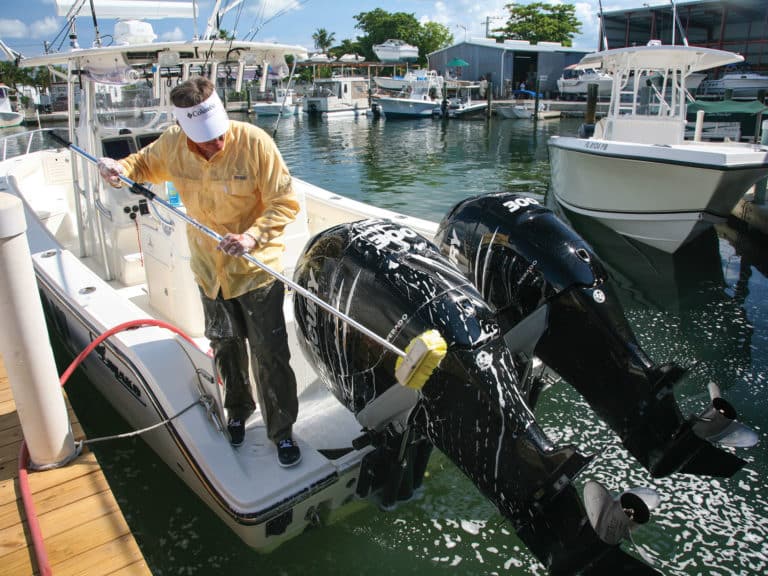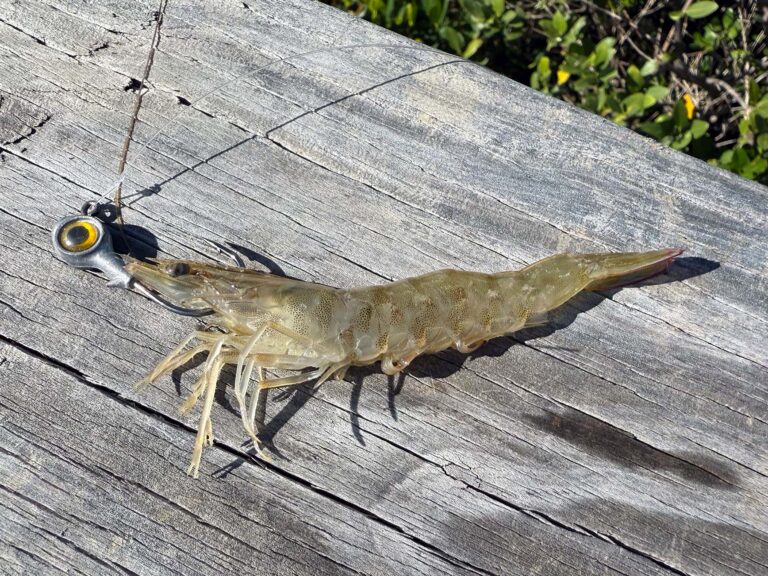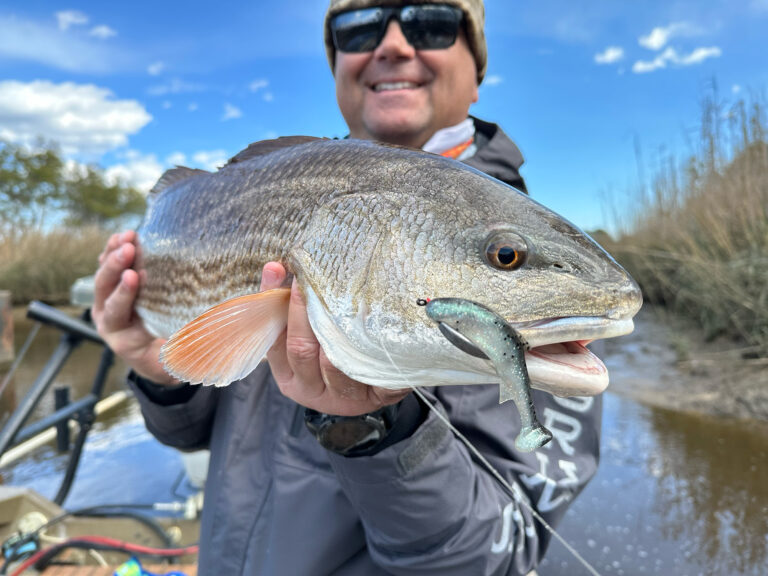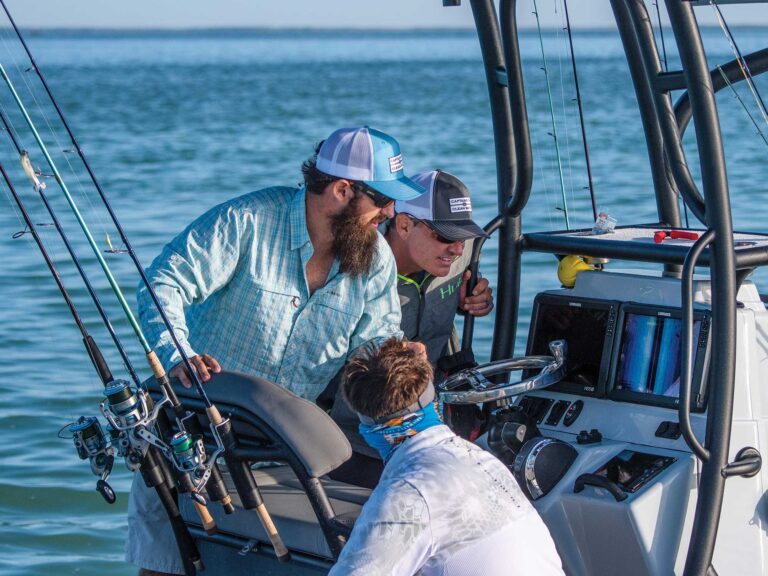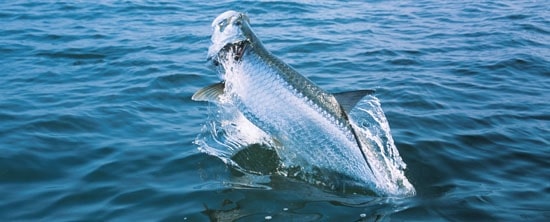
HIGH FLYER: Jumping tarpon are a common sight off Miami’s beaches in winter.
Photo: Jenni Bennett
The pasty-white snowbirds gorging on shrimp buffets in Miami’s South Beach have no idea that just offshore countless tarpon are also enjoying a shrimp feast of their own. These tarpon move in at the first of the year and spend most of the winter slurping down shrimp that pour through the area’s cuts on outgoing tides. The feeding action goes full-bore in February, which is exactly why I ducked out of last year’s Miami International Boat Show to sample this productive fishery.
I had heard from numerous sources that Captain Gavet Tuttle had the tarpon dialed in, so I jumped at the chance to join him for an afternoon of fishing aboard his Shearwater 24. My girlfriend, Jenny, and I met Tuttle at 4:30 p.m. at the Haulover Park boat ramp. As we motored out of Biscayne Bay, Tuttle let on that the previous couple of days had been red hot, but in typical fishing-guide fashion he promised nothing besides a beautiful afternoon on the water.
“It’s funny,” Tuttle said. “Most people think you need to go to Boca Grande or the Keys to catch a tarpon. They don’t realize what an amazing fishery we have here.”
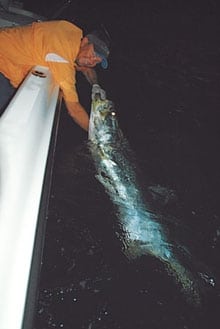
| |KING OF KINGS: Captain Tuttle prepares to release an average-sized Miami tarpon. Photo: Courtesy of Captain Gavet Tuttle| Tuttle added that most tarpon off Miami averaged around 80 pounds and hooking up to a couple of fish an outing was typical. “I ran about 80 tarpon trips last winter, and had only four days when we didn’t have a fish on the line.” Best of all, there’s hardly any pressure on these fish. Tuttle is one of three guides who work the area.
The Right Bait
We weren’t more than a few minutes outside Haulover Inlet when we spotted a rolling tarpon. “That’s a good sign,” Tuttle said. “They’re right where we left them last night.” And with that, he pulled back on the throttle and grabbed two rods. Tuttle uses 20-pound conventional tackle when targeting these fish. Unlike flats-style fishing in the Keys, you don’t sight-cast to Miami tarpon. Tuttle prefers to free-line live shrimp about 130 feet behind the boat while drifting.
“People can’t believe a 100-pound fish will eat a shrimp the size of your pinky but it’s what they want,” Tuttle said. “These tarpon have no interest in a three-pound mullet.”
As he surveyed the water, Tuttle grabbed a shrimp from the live well and pinned an 8/0 Gamakatsu circle hook through its head. We tossed two lines out and began the drift.
If no fish are showing, Tuttle drifts the troughs off the beach or between rocky patches of reef anywhere from six to 20 feet deep.
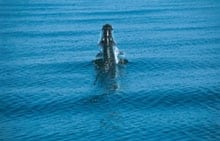
| |READY, SET, LEAP: When a big tarpon heads skyward make sure to bow the rod. Photo: Jenni Bennett| “Sometimes the fish will show up right at the mouth of the cuts, and other times they’ll be two miles south of the cuts,” says Tuttle, who, on any given day, will target water from Port Everglades to Government Cut. We were no more than a 1/4-mile south of Haulover Inlet and what seemed like spitting distance to shore.
We hadn’t been drifting five minutes when the line on the port rod tightened and the drag sang.
“Just let it hook itself,” Tuttle said. Easier said than done, as the rod began to point at the water like some possessed divining stick. Then Tuttle gave me the signal. I eagerly grabbed the rod and came tight to the fish, sending the tarpon leaping and gyrating in the fading afternoon light.
“Works every time,” Tuttle said.
After a 20-minute fight, the 70-pound fish neared the boat with the circle hook planted firmly in the corner of its jaw. Within moments it was released. Jenny was up next.
Fight Night
Tuttle’s drifts normally last about 15 minutes, during which time he wants his baits to work naturally beneath the surface. If it’s a breezy day, he’ll let out enough line so the shrimp don’t skip along the surface. On this afternoon, the wind was blowing in mild puffs as the sun sank toward the high-rises lining the beachfront. But there was little time to savor a Florida sunset once the port rod came alive again. Jenny reeled tight, and after a brief run a massive tarpon broke the surface-its body rising and rising straight out of the water until there seemed no end.
“Whoa!” Tuttle said. “That’s a nice one!” Indeed, her fish dwarfed my previous catch. “I’m guessing 170…180. Time to get to work.”
Forty-five minutes later, Jenny opted for a much-needed break and I stepped in-only to get manhandled by the fish.
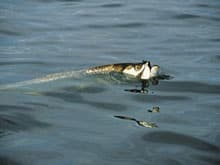
| |ON A ROLL: If a tarpon rolls during the fight, it’s gathering strength. Photo: Jenni Bennett| The big tarpon made bulldogging runs, jumped a half dozen times and even rolled as I applied every ounce of pressure I could put on the rod. “Some of them just have more fight than others,” Tuttle said. “Looks to me like you’re doing everything right.”
The sun sank and the moon rose, but the tarpon kept at it. While not working the boat to my advantage, Tuttle fielded cell-phone calls from his guide buddies. “Yep,” he said into the phone, “we’re still on it.” By now, Jenny was rather pleased with her decision to work as a team on this monster fish.
The fight ended an hour later. With my arms and legs quivering and sweat darkening my long-sleeve T-shirt, the fish finally came to boatside. Tuttle took a thumping as he wrestled the hook from the tarpon’s maw, but he managed to pull it free without getting yanked overboard. After watching the fish kick free, we exchanged high-fives and hollered into the night sky.
Then Tuttle knowingly looked us over and asked, “One more drift?” _To book a trip with Captain Gavet Tuttle, call (954) 448-1211 or visit www.backformore.com_
Tarpon That Won’t Quit
Show the king who’s boss.
Ask any angler who has tangled with tarpon and he’ll tell you that some fish have more giddyup than others.
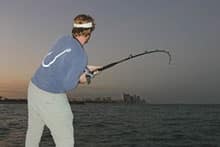
|
|RIGHT ANGLER: Change the angle of the rod to keep a fish off-balance. Photo: Jenny Everett |
I’ve seen 40-pound fish fight like tarpon three times their size and true behemoths that lolled more than battled. No matter the size, when you get a fish that doesn’t quit you’ll need to employ a few tricks to finish the battle quickly. Keep your rod lowered to either side of your body to apply the most pressure. Also try to keep the fish off-balance by changing the angle of the rod. This often encourages tarpon to jump, which helps tire them out. Near the end of the battle, thumbing the spool for added pressure also helps. And, remember, when you rest the fish rests, so fight it hard. Tarpon are too game to deserve anything less.
– D.D.





